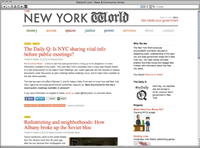 NEW YORK, NEW YORK — Last October 18, the day The New York World went live with a mission to expand journalism education and hold local and state governments accountable, editor Alyssa Katz posted a story by World reporter Sasha Chavkin about a private bus line in Brooklyn that ran a city bus route under a franchise agreement. Despite being open to all New York residents, the line primarily served Orthodox Jewish communities, and women had to ride separate from men on its routes.
NEW YORK, NEW YORK — Last October 18, the day The New York World went live with a mission to expand journalism education and hold local and state governments accountable, editor Alyssa Katz posted a story by World reporter Sasha Chavkin about a private bus line in Brooklyn that ran a city bus route under a franchise agreement. Despite being open to all New York residents, the line primarily served Orthodox Jewish communities, and women had to ride separate from men on its routes.
- Read more about The New York World
-
“Women had to ride in the back of the bus,” Katz remembers. “So we did a story about this, about how the city had effectively endorsed this bus line and given it a franchise.”
The story went viral. Not only did The New York Times, the New York Post, NPR, The Huffington Post, and others pick it up, but also the BBC and The Guardian.
“It generated a massive amount of traffic and attention for us. And everybody, with few exceptions, mentioned The New York World as the source of the story, which was an incredible accomplishment for our first day of publication,” Katz says. The bus company ended segregation about a week later.
Named after Columbia University Graduate School of Journalism founder Joseph Pulitzer’s newspaper, which folded in 1931, the World operates as “a teaching-hospital approach towards journalism,” according to faculty advisor Bill Grueskin, dean of academic affairs and professor of professional practice. “[Graduates] are doing real journalism that gets picked up by lots of sites and also gets traffic to our own site. But they’re really doing it under the tutelage of highly experienced journalists.”
The distribution strategy includes getting picked up by other outlets, as well as having them link back to The New York World, Katz says. She estimates average site traffic at 60,000 unique visitors per month, but also counts more than 1 million listeners or readers for stories picked up by WNYC radio, the Albany Times Union, the Queens Chronicle, the Forward, and other venues.
(Full disclosure: CJR is published by the Columbia University Graduate School of Journalism. Neither the author of this article nor its editor is a Columbia alum.)
Katz works alongside a deputy interim editor, and the site is also recruiting a deputy editor to handle digital projects full-time. Additional staff consists of six reporters on one-year fellowships. All are alumni of the journalism school. Most are recent graduates, but a couple have spent a year or more on other journalism jobs. The school is now reviewing applicants for the World’s second year of operation.
Katz likens the reporters to medical residents, picking up on Grueskin’s teaching-hospital analogy to describe the World as “an immersive, real-stakes opportunity to put to work skills that have been learned in the core professional-school education.”
Katz, a veteran of the Village Voice, Spin, The Nation, and other magazines, says inspiration for the site sprang from Leonard Downie Jr. and Michael Schudson’s report The Reconstruction of American Journalism, which was published in CJR’s November/December 2009 issue.
“One of the recommendations in the report was that independent organizations really needed to step up and produce journalism that holds local and state governments accountable–that that function wasn’t being adequately served in the marketplace,” Katz recalls. “And so at a certain point I think the deans decided to put their money where their mouth is and actually make a serious effort to create that sort of institution within the Columbia School of Journalism…. That report was really the jumping-off point.”
Grueskin estimates that The World costs about $700,000 to operate. Funding comes largely from foundations and alumni donors, including the Barth Family Fund of the Dallas Foundation, Renée S. Edelman ’80, the John S. and James L. Knight Foundation, the Eleanor & Howard Morgan Family Foundation, the Rockefeller Family Fund, and Rick Smith ’70, and most recently the Rockefeller Brothers Fund. In addition, Columbia supports the World with office space, and access to the faculty for advice and expertise.
Digital innovation is part of the mission, Katz says. The site takes inspiration from The Texas Tribune and other local sites that focus on data vizualization. When it was discovered that Zuccotti Park–of Occupy Wall Street fame–was not a public park but a privately owned space, Katz assigned reporter Yolanne Almanzar to find other privately owned public spaces like Zuccotti Park around the city and report on how open they were to the public. As it turned out, the spaces were often not accessible, at least not at the hours or in the manner they were supposed to be. Reporter Michael Keller followed up by creating a map of those sites that allowed readers to contribute. So far readers have posted reviews of about 150 spaces.
In a video posted on the site’s about page, World reporter Almanzar says that working for the site has helped her grow comfortable with her role as a journalist amid changes within the industry.
“I wanted to know that I was going to be a part of those changes and working at a place like The New York World really makes me feel comfortable with the kind of journalist I’m going to become,” she says.
-
The New York World Data
Name: The New York World
City: New York
Tom Marcinko is a writer in Phoenix.
